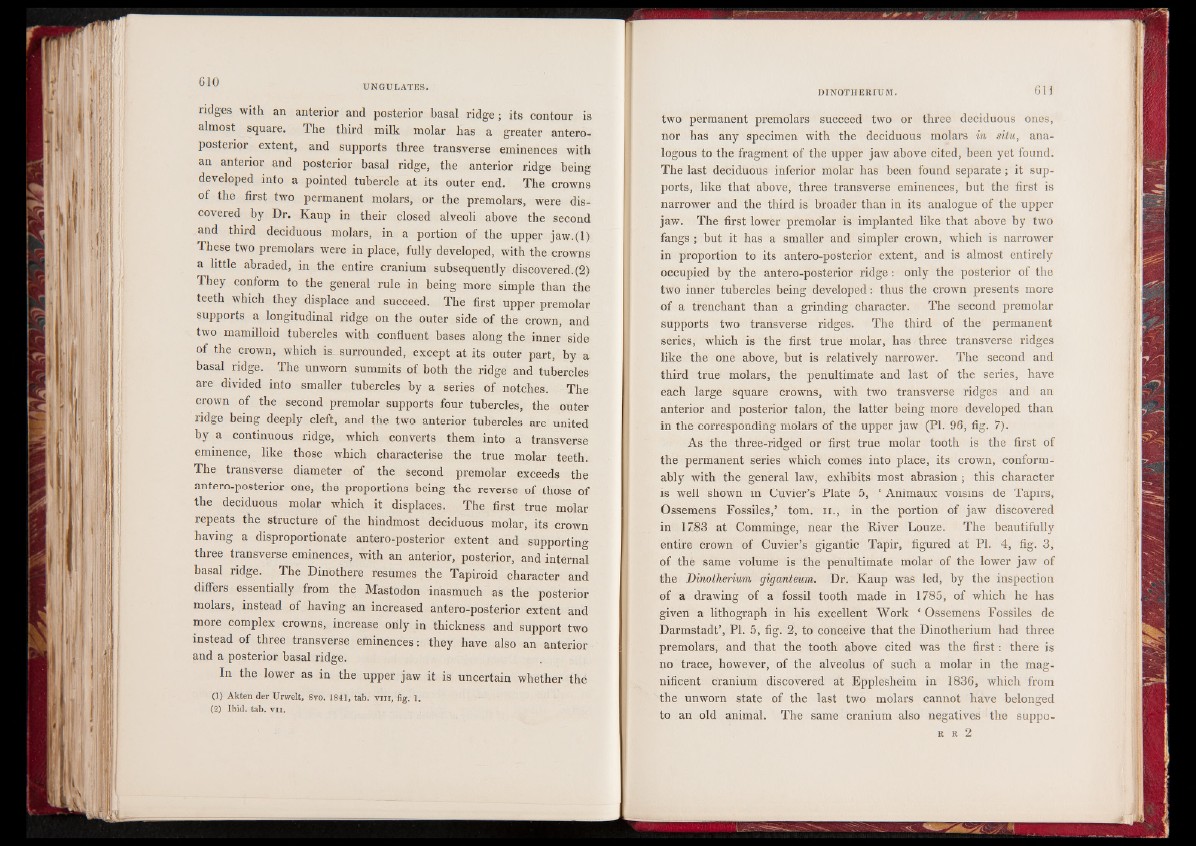
ridges with an anterior and posterior basal ridge; its contour is
almost square. The third milk molar has a greater anteroposterior
extent, and supports three transverse eminences with
an anterior and posterior basal ridge, the anterior ridge being
developed into a pointed tubercle at its outer end. The crowns
of the first two permanent molars, or the premolars, were discovered
by Dr. Kaup in their closed alveoli above the second
and third deciduous molars, in a portion of the upper jaw.(l)
These two premolars were in place, fully developed, with the crowns
a little abraded, in the entire cranium subsequently discovered.(2)
They conform to the general rule in being more simple than the
teeth which they displace and succeed. The first upper premolar
supports a longitudinal ridge on the outer side of the crown, and
two mamilloid tubercles with confluent bases along the inner side
of the crown, which isu surrounded, except at its outer part, by a
basal ridge. The unworn summits of both the ridge and tubercles
are divided into smaller tubercles by a series of notches. The
crown of the second premolar supports four tubercles, the outer
ridge being deeply cleft, and the two anterior tubercles are united
by a continuous ridge, which converts them into a transverse
eminence, like those which characterise the true molar teeth.
The transverse diameter of the second premolar exceeds the
antero-posterior one, the proportions being the reverse of those of
the deciduous molar which it displaces. The first true molar
repeats the structure of the hindmost deciduous molar, its crown
having a disproportionate antero-posterior extent and supporting
three transverse eminences, with an anterior, posterior, and internal
basal ridge. The Dinothere resumes the Tapiroid character and
differs essentially from the Mastodon inasmuch as the posterior
molars, instead of having an increased antero-posterior extent and
more complex crowns, increase only in thickness and support two
instead of three transverse eminences: they have also an anterior
and a posterior basal ridge.
In the lower as in the upper jaw it is uncertain whether thé
(1) Akten der Urwelt. 8vo. 1841, tab. vui/fig. 1.
(2) Ibid. tab. vn.
two permanent premolars succeed two or three deciduous ones,
nor has any specimen with the deciduous molars in situ, analogous
to the fragment of the upper jaw above cited, been yet found.
The last deciduous inferior molar has been found separate; it supports,
like that above, three transverse eminences, but the first is
narrower and the third is broader than in its analogue of the upper
jaw. The first lower premolar is implanted like that above by two
fangs ; but it has a smaller and simpler crown, which is narrower
in proportion to its antero-posterior extent, and is almost entirely
occupied by the antero-posterior ridge : only the posterior of the
two inner tubercles being developed: thus the crown presents more
of a trenchant than a grinding character. The second premolar
supports two transverse ridges. The third of the permanent
series, which is the first true molar, has - three transverse ridges
like the one above, but is relatively narrower. The second and
third true molars, the penultimate and last of the series, have
each large square crowns, with two transverse ridges and an
anterior and posterior talon, the latter being more developed than
in the corresponding molars of the upper jaw (PI. 96, fig. 7).
As the three-ridged or first true molar tooth is the first of
the permanent series which comes into place, its crown, conformably
with the general law, exhibits most abrasion ; this character
is well shown in Cuvier’s Plate 5, ‘ Animaux voisins de Tapirs,
Ossemens Fossiles,’ tom. n., in the portion of jaw discovered
in 1783 at Comminge, near the River Louze. The beautifully
entire crown of Cuvier’s gigantic Tapir, figured at Pl. 4, fig. 3,
of the same volume is the penultimate molar of the lower jaw of
the Dinotherium giganteum. Dr. Kaup was led, by the inspection
of a drawing of a fossil tooth made in 1785, of which he has
given a lithograph in his excellent Work ‘ Ossemens Fossiles de
Darmstadt’, PI. 5, fig. 2, to conceive that the Dinotherium had three
premolars, and that the tooth above cited was the first: there is
no trace, however, of the alveolus of such a molar in the magnificent
cranium discovered at Epplesheim in 1836, which from
the unworn state of the last two molars cannot have belonged
to an old animal. The same cranium also negatives the support
r 2